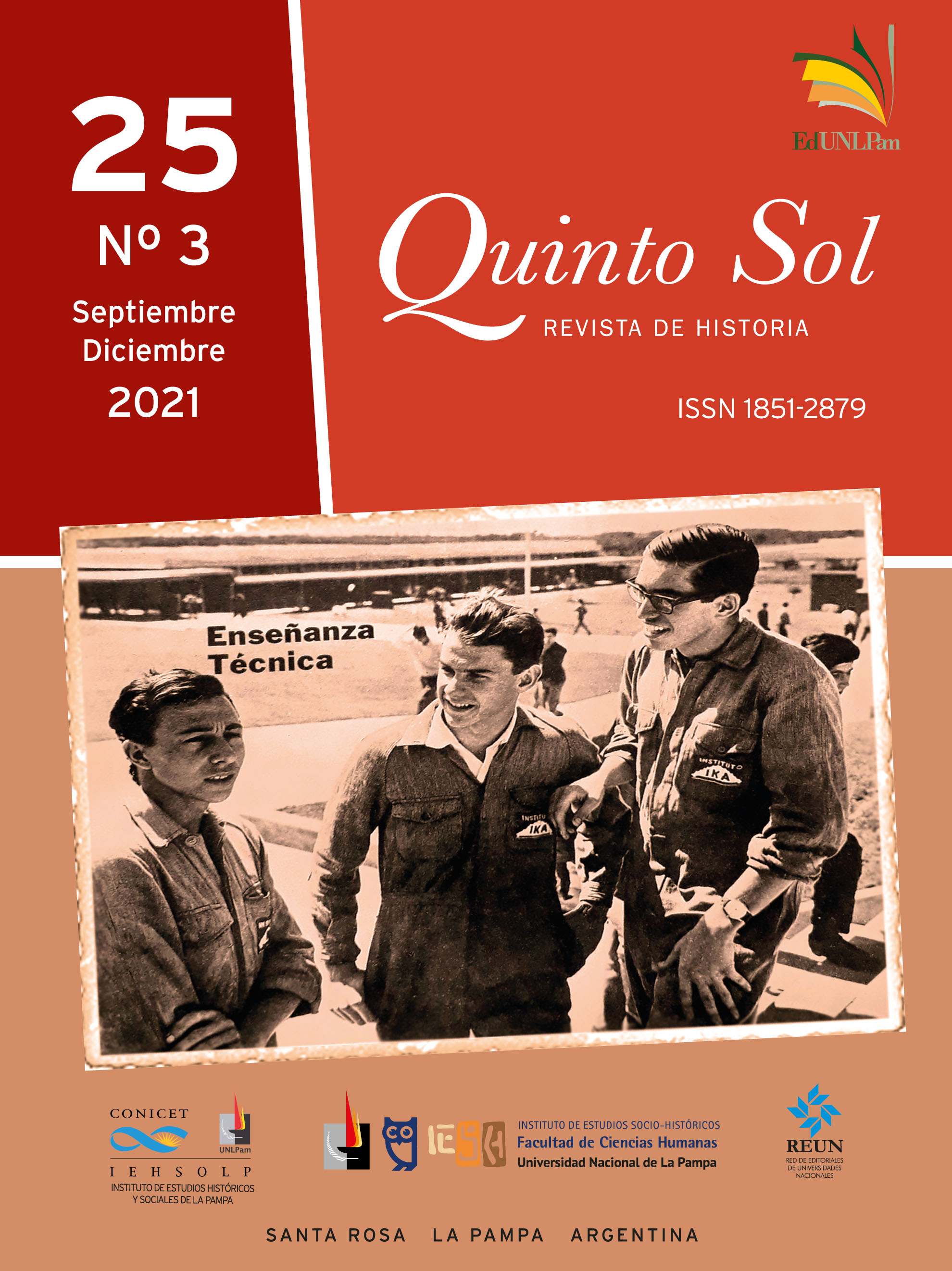Partisanship and Populism: the Comando de Organización in the Province of Chaco (1973-1976)
DOI:
https://doi.org/10.19137/qs.v25i3.5261Keywords:
partisanism, Peronism, political violenceAbstract
Studies about Peronism at subnational levels as well as research addressing the political violence in the sixties and seventies are consolidated fields in Argentinian historiography. Furthermore, articles on Peronist groups that opposed the sector led by Montoneros have been published in the last fifteen years. In that line of inquiry, various investigations have considered provincial and local settings where intense factional conflicts arose inside the Peronist party. At the intersection of those historiographical questions, this research centers on the case of the Comando de Organización (CO) in the Province of Chaco during the period 1973-1976 and focuses on two conceptual issues. The first one, in line with some key theoretical principles provided by Carl Schmitt’s Theory of the Partisan, poses a description of the type of political violence inflicted by this organization. The second issue refers to the discussion about the use of the term right-wing Peronism to define diverse anti-Montoneros actors. To this end, the ideological propositions of the CO in Chaco are compared with the ideas traditionally held by the Peronist populism.
Downloads
References
Altamirano, C. (2011). Peronismo y cultura de izquierda. Siglo XXI.
Anzaldi, P. (2016). Los años 70 a fondo. Guerrilleros, militares y familiares. Reportajes inéditos a los protagonistas de la Argentina violenta. SB.
Arias, M. y Heras, R. (1993). Carisma disperso y rebelión: los partidos neoperonistas. En S. Amaral y M. B. Plotkin (Comp.) Perón, del exilio al poder (pp. 95-125). Cántaro.
Bucciarelli, M. (2009, 8 de octubre). La Patagonia argentina como Territorio Nacional. Perspectivas de análisis [ponencia]. VIII Congreso de Historia Social y Política de la Patagonia Argentino-Chilena, Chubut, Argentina. http://historiapolitica.com/datos/biblioteca/ariasb2.pdf
Bufano, S. y Teixidó, L. (2015). Perón y la Triple A. Las 20 advertencias a Montoneros. Sudamericana.
Ciria, A. (1983). Política y cultura popular. La Argentina peronista 1946-1955. De la Flor.
De Ipola, E. y Portantiero, J. (1989). Lo nacional-popular y los populismos realmente existentes. En E. De Ipola, Investigaciones políticas (pp. 21-36). Nueva Visión. (Original publicado en 1981).
Denaday, J. (2016). Comando de Organización: un peronismo plebeyo, combativo y nacionalista (1961-1976). Quinto Sol, 20 (1), pp. 1-21. http://dx.doi.org/10.19137/qs0832
Denaday, J. (2017). Notas para el debate historiográfico sobre el peronismo de los setenta. Pasado Abierto, 5, 115-136. https://fh.mdp.edu.ar/revistas/index.php/pasadoabierto/article/view/2192/0
Firmenich, M. (1973). Charla de la Conducción Nacional ante las agrupaciones de los frentes. En R. Baschetti (Comp.) (1996). Documentos1973-1976. De Cámpora a la ruptura (pp. 258-311). De la Campana.
Germani, G. (2003). Autoritarismo, fascismo y populismo nacional. Temas. (Original publicado en 1978).
Leoni, M. S. y Solís Carnicer, M. (2015). Peronismo, diseño institucional y centralización política. Un análisis a partir de dos espacios subnacionales argentinos: Corrientes y Chaco (1946-1955). Iberoamericana, XV (60), 61-79. https://doi.org/10.18441/ibam.15.2015.60.61-79
Macor, D. y Tcach, C. (2013) (Comp.) La invención del peronismo en el interior del país II. Universidad Nacional del Litoral.
Macor, D. y Tcach, C. (Comps.) (2014). La invención del peronismo en el interior del país. Universidad Nacional del Litoral. (Original publicado en 2003).
Maeder, E. (1996). Historia del Chaco. Plus Ultra.
Marcilese, J. (2017). El peronismo bonaerense: facciones, lealtades y tensiones. De la Convención de Avellaneda a la Revolución Argentina (1965-1966). Estudios Sociales, 34, 11-38. https://doi.org/10.14409/es.v53i2.7024
Michanie, M. (2018). Maestro de maestros. Instituto Nacional de Cine y Artes Audiovisuales.
Nadra, F. (1974). Un año de gobierno peronista. Sílaba.
Ollier, M. (2006). Golpe o revolución. La violencia legitimada, Argentina 1966/1973. Universidad Nacional de Tres de Febrero. (Original publicado en 1986-1989).
Ory, P. (2012). Del fascismo. Nueva visión. (Original publicado en 2003).
Rozitchner, L. (2012). Perón: entre la sangre y el tiempo. Lo inconsciente y la política. Biblioteca Nacional. (Original publicado en 1984).
Ruffini, M. (2005). Peronismo, territorios nacionales y ciudadanía política. Algunas reflexiones en torno a la provincialización. Avances del Cesor, 5, 132-148. http://biblioteca.clacso.edu.ar/Argentina/cehepyc-uncoma/20110414122415/Ruffini.pdf
Schmitt, C. (2013). Teoría del partisano. Acotación al concepto de lo político. Trotta. (Original publicado en 1963).
Servetto, A. (2010). 73/76. El gobierno peronista contra las “provincias montoneras”. Siglo XXI.
Sidicaro, R. (2010). Los tres peronismos. Estado y poder económico. Siglo XXI. (Original publicado en 2002).
Solís Carnicer, M. y Maggio, M. (2019). Posibilidades y limitaciones del uso de la prensa como fuente para la reconstrucción de la historia política en el nordeste argentino: algunas notas sobre Corrientes y Chaco (Primera mitad del siglo XX). Folia Histórica del Nordeste, 34, 151-168. https://ri.conicet.gov.ar/handle/11336/121186
Svampa, M. (2007). El populismo imposible y sus actores, 1973-1976. En D. James (Dir.) Violencia, proscripción y autoritarismo (1955-1976) (pp. 381-438). Sudamericana. (Original publicado en 2003).
Verbitsky, H. (1995). Ezeiza. Planeta. (Original publicado en 1985).
Vezzetti, Hugo (2013). Sobre la violencia revolucionaria. Memorias y olvidos. Siglo XXI. (Original publicado en 2009).
Downloads
Published
Issue
Section
License
When submitting their contributions, authors must declare that they have the permission of the file or repository where the documents that are attached to the work were obtained, whatever their format (unpublished manuscripts, images, audiovisual files, etc.). Such permission authorizes their publication and reproduction, releasing the journal and its editors from any liability or claim from third parties.
Likewise, authors must adhere to the Creative Commons license called "Attribution - Non-Commercial CC BY-NC-SA", through which the author allows copying, reproducing, distributing, publicly communicating the work and generating derivative works, as long as the original author is properly quoted and acknowledged. It is not allowed, however, to use the work for commercial purposes. Authors may establish additional agreements for the non-exclusive distribution of the version of the paper published in the journal (for example, placing it in an institutional repository or publishing it in a book), with the acknowledgment of having been published first in this journal.
The publication of content in this journal does not imply any royalty or charge for taxpayers.
Quinto Sol adheres to the DORA (Declaration on Research Assessment) signed in San Francisco, California, on December 16, 2012, and to the Declaration of Mexico (Joint Declaration LATINDEX - REDALYC - CLACSO - IBICT).










4.png)
2.png)












_(2).png)


1.jpg)



1.jpg)





